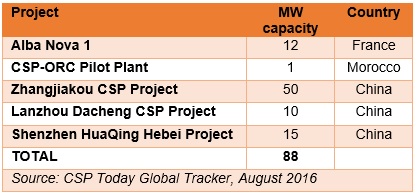CSP competition heats up as Fresnel design taps higher temperatures
Frenell's latest CSP plant design incorporates a higher-temperature molten salt system to provide overnight storage and a lower cost of energy in a move which could boost lagging Fresnel deployment.

Global installed Fresnel CSP capacity is currently around 177 MW, compared with 4.2 GW of parabolic trough capacity and 629 MW of CSP tower capacity, according to the CSP Today Global Tracker.
While Fresnel designs offer some cost advantages in manufacturing and installation, advancement of these systems was hindered by an inability to operate at temperatures high enough to provide energy storage.
The provision of energy storage has become a key driver of CSP development and competition could intensify as Germany's Frenell recently announced the first commercially available linear-focusing technology that uses molten salts as a Heat Transfer Fluid (HTF) and Thermal Energy Storage (TES) medium.
Frenell's DMS technology uses molten salt as the HTF directly in the collector, allowing the integration of TES with a direct two-tank molten salt storage system.
As opposed to a parabolic trough collector with synthetic oil as HTF, no oil-salt heat exchangers are required and salt storage temperature is not limited to the maximum oil-HTF temperature, Anton Hoffmann, project engineer at Frenell, told CSP Today.
“The increased HTF temperatures to up to 550 degrees Celsius allows the application of advanced reheat Rankine-cycle steam turbines that will increase power block efficiency significantly,” Hoffmann said.
This improvement could lower the Levelized Cost of Electricity (LCOE) to between $50/MWh and $70/MWh, based on baseload power generation with more than 15 hours of TES, according to Frenell.
This price is lower than forecasts for other CSP technologies.
International Renewable Energy Agency (IRENA) recently forecast the LCOE of parabolic trough plants will fall by 37% to $90/MWh by 2025, and the generation cost of solar towers is set to fall by 43% to $80/MWh.
Structure savings
Fresnel systems benefit from several manufacturing and installation advantages over parabolic troughs, Hoffmann said.
The primary mirrors are made of flat float-glass mirrors which cost less to manufacture than curved mirrors used in parabolic trough designs, he said.
The Fresnel mirror field is typically situated closer to the ground and less susceptible to wind loads, requiring a relatively lean support structure, using low-cost coil steel and standard steel profiles.
In addition, the collector receiver on a Fresnel system does not require the rotary joints which are used on parabolic trough systems, or flexible hoses between collector units, which further reduces costs, Hoffmann said.
“This is particularly important for the use of molten salt since rotary and flexible pipe connections proved to be technically challenging in combination with molten salt fluid,” he said.
A high proportion of commercial bank lending in completed Fresnel projects highlights the bankability of the underlying technology.
The 125 MW Reliance Areva CSP 1 project in India is the largest Fresnel CSP plant to date and the project was 70% financed through foreign debt, 5% local debt and 25% equity.
The 30 MW Puerto Errado 2 plant in Spain, which uses Frenell´s collector and has been in operation since May 2012, sourced debt from three European commercial banks.
Linear Fresnel CSP projects under construction

Industrial openings
Industrial applications represent market opportunities for Fresnel technology, Michele Scandellari, CEO of solar developer Enerray, told CSP Today.
Enerray was created in 2007 by Italian conglomerate Maccaferri Group and has mainly focused on PV development. In 2014, the firm was selected to develop the 1 MW CSP-Organic Rankine Cycle (ORC) demonstration plant which will generate electricity and heat for industrial processes.
The plant consists of a linear Fresnel concentrator alongside a small operational parabolic trough system and is expected to come online in September.
The cost of the plant is estimated at 6.5 million euros ($7.4 million) and Morocco’s OCP Group, the largest phosphate producer in the world, is financing the plant to assess its productivity for potential future applications.
“Industrial applications, especially in the mining sector, are a very interesting field for Fresnel technology in terms of electricity and heat production,” Scandellari said.
The most suitable mining sites would be those located in areas with high levels of direct solar radiation, such as Morocco, South Africa, Chile, and parts of Brazil and Western Australia, he said. New markets like Iran could also offer opportunities, he noted.
Frenell’s use of molten salt storage marks an advancement for Fresnel designs and Hoffman believes wider deployment of Fresnel projects in the coming years will lead to further cost reductions.
“Linear Fresnel technology is only at the beginning of a cost reduction development,” he said.
By Heba Hashem
